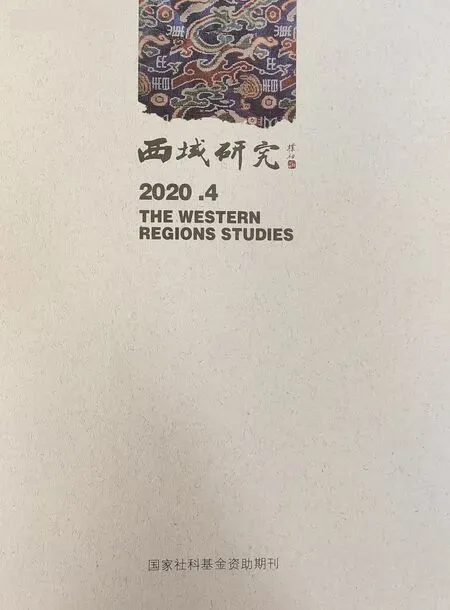英文摘要 关键词
2020-10-14
About"Can’tgraspthepoint"forZhangQianandtheOpeningoftheSilkRoad
MengXianshi(1)
Abstract:The west missions of Zhang Qian were failed to achieve at all.The Da-Yue-Zhi and Wu- Sun whom Western Han placed high hope on were lacked understanding of the Han Dynasty.This was the key to Zhang Qian’s failure to achieve his mission and that is why describing Zhang Qian as "can’t grasp the point" in the history books.This fact profoundly proves the significance of Zhang Qian’s "Zao-Kong (open the way)".Zhang Qian’s mission to the Western Regions is one of the major events in human history.As the main platform of human activities,from then,Eurasia began to move towards the initial "integration",and political ties between civilizations and countries were initiated.If saying the Age of Discovery opened the second phase of globalization,then Zhang Qian’s mission to the Western Regions and the opening of the Silk Road was the beginning of the first phase of globalization.
Keywords:Zhang Qian(张骞);Huns;Western Regions;Silk Road
ParthianEasternExpeditionandtheTortuousDevelopmentoftheMiddleSection
oftheSilkRoad
WangSansan(11)
Abstract:The migration wave of Saka caused by moving westwards of the Da-Yue-Zhi during the 2nd century BC resulted in serious problems on the border of the Parthian Empire.The Eastern Expedition of Mitridati I pushed the Parthians’ power eastward to the Mulu and even to the Transoxiana,and the Samarkand Road which was under the control of the Parthians then became unblocked.Soon after,the Saka invaded again,and the situation in the eastern part of the empire was in an emergency.Along with the Eastern Expedition of Mithridati II,the Parthians were finally able to control the area from the Mulu east to the middle of the Amu Darya.The Parthians’ Eastern Expedition not only resolved the border problems but also established the unified order of the empire which objectively guaranteed the formation of an effective trade pattern in the middle section of the Silk Road.This laid the foundation for the final connection of the Silk Road in the Zhang Qian period.
Keywords:Parthian Empire;Mithridates I;Mithridates II;Eastern Expansion;Silk Road
WhereistheRegionbetween"theQilianMountainsandDunhuang"?
WangJianxin,WangQian(27)
Abstract:It has been a viewpoint within the mainstream that "the region between the Qilian Mountains and Dunhuang" where was the Yuezhi originally lived in before moved to the further west should mean the west Hexi Corridor.Through the reanalysis of historical records for the marching goals,routes,processes,and results of General Huo Qubing attacking Huns twice in the second year of Yuanshou of Emperor Wu of the Han Dynasty,and combined with the studies on the unearthed documents,environmental data and archaeological evidence,this article further clarifies that the Qilian Mountain today is not the Qilian Mountain in Han Dynasty.The Qilian Mountain in the Han Dynasty should be the Eastern Tianshan.Yue’s hometown is unlikely to be in the west of the Hexi Corridor and should be in the area centered on the Eastern Tianshan today.
Keywords:Yuezhi;Qilian;East Tianshan;Dunhuang;Hexi Corridor
TheDeclineofthe"He-Qin" (politicalmarriage)SystemwithHunsintheEarlyWestern
HanDynasty:AnAnalysisoftheStagedChangesintheRelationshipbetween
theHanandHunsaroundthe14thyearofEmperorWen
LiuYuchen(39)
ResearchonXinjiangSocialEducationduringtheComprehensiveAnti-JapaneseWar:
AnInvestigationfromthePerspectiveofPoliticalMobilization
XieFei(49)
EvaluationontheResearchofPrehistoricMobilePastoralistArchaeology
amongtheEurasianSteppe
CongDexin,JiaWeiming(59)
Abstract:Archaeological societies began to notice the mobile pastoralists can be traced back to the 1970s.In the late 20th century,foreign scholars represented by the Soviet archaeologist Khazanov made certain achievements in the concept,classification,origin of nomadism and the judgment criteria,method for ancient sites of nomadism in the theory and practice of prehistoric nomadic archaeology.This article takes the Begash,the Tasba as well as the research on the prehistoric mobile pastoralist archaeology in the Talga River Basin,and the zooarchaeology in the Balkans as examples,to reassess and review the achievements by foreign scholars in this field.The review of Chinese archaeology on prehistoric pastoralists and mobile pastoralists focuses on three typical sites in the Tianshan area of Xinjiang,and Tibet respectively.The use of all means to actively carry out research and exploration of the dietary production model is the big trend of current prehistoric nomadic archaeology in the Eurasian steppe.
Keywords:Transhumance archaeology;Ethnoarchaeology;Dietary Production Model;Origins of transhumance;Begash site;Tasbas site;Adunqiaolu site
ThoughtsontheDevelopmentProcessoftheIntegrationofAgricultureandHerding
andtheOriginofAnimalHusbandryinNorthernChina
WeiJian,FengBao(79)
Abstract:This article selects central Inner Mongolia,western Liaoning and northern Xinjiang as the research objects.On the basis of summarizing archaeological excavation materials,using the latest research results of animal and plant archaeology,environmental archaeology,and physical anthropology,combing C14 dating and DNA data,under the broader background of the Mongolian plateau and Eurasian steppes to discuss the integration of agriculture and herding and the origin of animal husbandry in northern China.It is believed that from the early large-scale settlements dominated by hunting and gathering,to the prosperity of agricultural settlements in the presence of hunting and gathering,then to the decline of the farming and the final formation of the animal husbandry economy,this process is the result of changing ecological environment and cultural adaptation, and the interaction of factors such as the migration of ancient ethnic groups.
Keywords:Northern China;Integration of agriculture and herding;Origin of animal husbandry;Settlement
DiscussionontheUrbanConstructioninNorthernTianshanArea-FromthePerspective
oftheContradiction,Conflict,Communication,andIntegrationbetweenFarming
andNomadicCultures
DongHongling(94)
StudyontheNewFoundSanskrit"OdetotheEightGreatStupas"
ZhangMengyan(106)

Keywords:Sanskrit scripts;Eight Great Stupas;Image of eight stages of Tathgata
OntheFragmentsoftheThreeAncientUighurScripts"gama"Preserved
inChineseNationalLibrary
Ayida’er·Mi’erkamali(123)
Abstract:All Uighur "gama" scripts were translated from Chinese during the Yuan dynasty but using the excerpted translation method and have the characteristic of writing a large number of Chinese characters in the scripts.This paper,at the first time,introduced the Uighur scripts of "gama" preserved at the Chinese National Library,and also analyzed its origin and characters.From the perspective of linguistics and literature,this article has identified these three should belong to theMadhyamgama(GT15-01),Dīrghgama(GT15-41) andSayuktgama(BieyiZaahanjing,GT15-02) respectively.
Keywords:The Chinese National Library;Ancient Uighur script;"gama";Translation of "Agama"
OntheTurkicCustomof"WorshipGhostsandGods"fromtheWord"bark"
intheInscription
ChenHao(134)
Abstract:In terms of belief practice,in addition to Shamanism,Buddhism,and Zoroastrianism,Chinese historical materials also mention that ancient Turkic "worship ghosts and gods and belief in witchcraft." Generally,scholars regard the "belief in witchcraft" here as the evidence of that ancient Turkic believed in shamanism,but as far as "worship ghosts and gods" is concerned,Chinese and foreign historians rarely discuss it.This article begins with the word "bark" on the Turkic inscription that was misread by most linguists,combining ancient Chinese records to reconstruct the practice of "worshiping ghosts and gods" among the Turkic ancients.In fact,the exact meaning of "bark" is "shrine",a place where ancient Turkic people "worship ghosts and gods".The enshrined in temples can be either enemy worthy of awe,or heroes of the nation.This reveals the richness of ancient Turkic beliefs.
Keywords:Ancient Turks;Worship ghosts and Gods;bark;Shrine
ShenglingZuo(SeatofLivingThings)inMeddleAgesandItsSpread
intheWesternRegionsinChina
WuZhenghao(139)
"IndraInvitingPancasikha"and"VisitingBuddha" --StudyontheMurals
abovethefrontandrearWallsintheCave92atKizil
YangBo(150)
ExploringandUnderstandingofInternalMigrationsandChanges-Review
on"StudyontheChangesofUyghurLiteraryFamilyintheYuanDynasty:
CenteredontheXie’sandLian’sFamilies"
LiYipeng(161)
